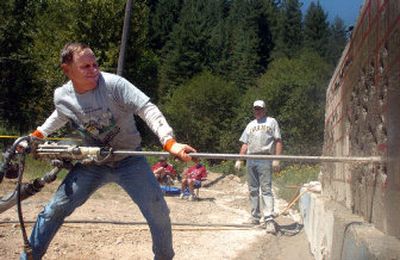Mining competition is a mucker’s dream

OSBURN, Idaho – Just as horse breeders dream of Churchill Downs and car racers long for Indianapolis, competitive miners throughout the Northwest head to this small town between Kellogg and Wallace when it comes time to measure who’s best.
Best at punching holes with a jackleg drill. Best at pounding spikes with the flat end of an axe. Best at shoveling a ton of muck into a car. And best at attacking a pile of gravel with a 12B mucking machine.
Miners who are really good at those underground jobs stood to make some money here Saturday at the 18th Coeur d’Alene District Mining Competition. Top prize in each event paid $500, and best score overall another $500.
But it really isn’t about the money, said Chuck Blasey, who came from Metaline Falls, Wash., with his wife, Jessica, and two small daughters.
“If there wasn’t any money, I’d still be here,” he said as daughter Hadley, age 1½, napped in the shade under a picnic table. “It’s a chance to talk with all my friends.”
Blasey has entered other drilling competitions in Washington and Montana but believes the field at Osburn is the toughest.
“Everybody goes to this. It’s the biggest in the Northwest,” he said.
Mining companies sometimes pay a miner’s way, he said, to have their name announced with the contestant’s.
Families come too, said Jessica Blasey, to get a glimpse of what miners do on the job. “I don’t get to go underground and see what he does.”
There are spike-driving contests for women and shoveling contests for children. Sheridan Blasey, not quite 4, was disappointed to be held out because the minimum age was 5.
Chuck Blasey was catching his breath after the jackleg competition, which consists of drilling two 1½-inch holes, 4 feet deep, into a 5-inch square painted on a block of concrete.
The pneumatic jackleg drill was a huge innovation when introduced in the 1950s but has been replaced in many mines by hydraulic drills, said competition organizer Bob McPhail. The contest uses a special “competition model,” running it without the muffler now required underground, so it’s a little lighter, at about 110 pounds, and considerably louder, at about 120 decibels.
“It’s the main reason old miners always say ‘Huh?’ when you talk to them,” McPhail said. Earplugs are strongly advised.
Like any activity that combines strength and skill, there’s a technique a driller develops with practice. If the jackleg is back far enough, the weight of the machine and the miner helps push the drillbit through the block, McPhail said.
Each contest has its own technique.
Pounding spikes into an overhead timber requires the proper swing, because the business end of the axe is sharp.
Running the 1930s era 12B mucking machine takes rhythm, said McPhail. The machine moves down a railed track on compressed air and has a scoop loader on the front that dumps into an open car on the rear. Most big mines now use larger, wheeled loaders, so older miners can have an edge on that competition.
Al Morrison, from the Greenstreak Mine outside of Juneau, Alaska, said hand-mucking – or shoveling a ton of loose rock into a small railcar – requires rhythm, too, and a properly formed pile of muck as the miner scoops, turns, dumps and turns back to the pile.
Morrison grew up in Philipsburg, Mont., and has been mining for about 17 years, 14 of them in Alaska. But the summers near Juneau are gray and wet, and he was enjoying the blue, cloudless August sky in North Idaho.
“I know a lot of these guys. Mining’s a pretty small world,” he said.
That world has shrunk since 1984, when the first Coeur d’Alene District competitions were held, said McPhail, who has been involved in every event. In the mid-‘80s, there were as many as 200 competitors at a two-day event.
In the late ‘80s and early ‘90s, mining got so bad in the Silver Valley that many of the young miners quit or moved elsewhere to find working mines, he said. The event wasn’t even held a few years, which is why it’s only the 18th competition in 21 years.
Families come to watch spouses or parents, to eat burgers or barbecue, and to just visit on a summer day.
“It’s something to do,” said Steve Croston of Kellogg, who has competed every year since the first contest and is generally acknowledged as the guy to beat.
After finishing second in spike driving, Croston was complaining to friends of a pulled stomach muscle. But he finished first in the other three events and won the overall competition.
“He competed one year with a cast and was best overall,” McPhail said. “We don’t believe his sandbagging anymore.”
The competition may be more than just a way to hang onto the past. It may also offer a glimpse of a slightly improving future. This year saw 50 competitors in the adult male events, about 10 more than 2004.
“We’re starting to get some of the younger guys back,” McPhail said. Back to the competition, back to mining and back to the Silver Valley.